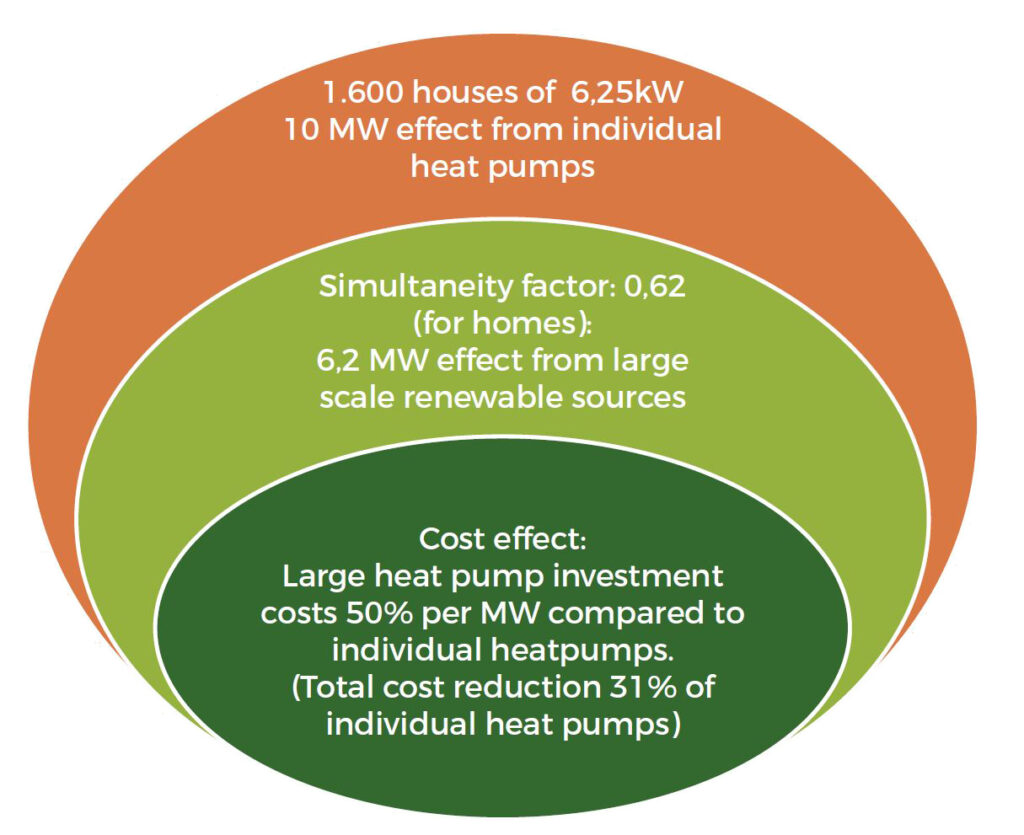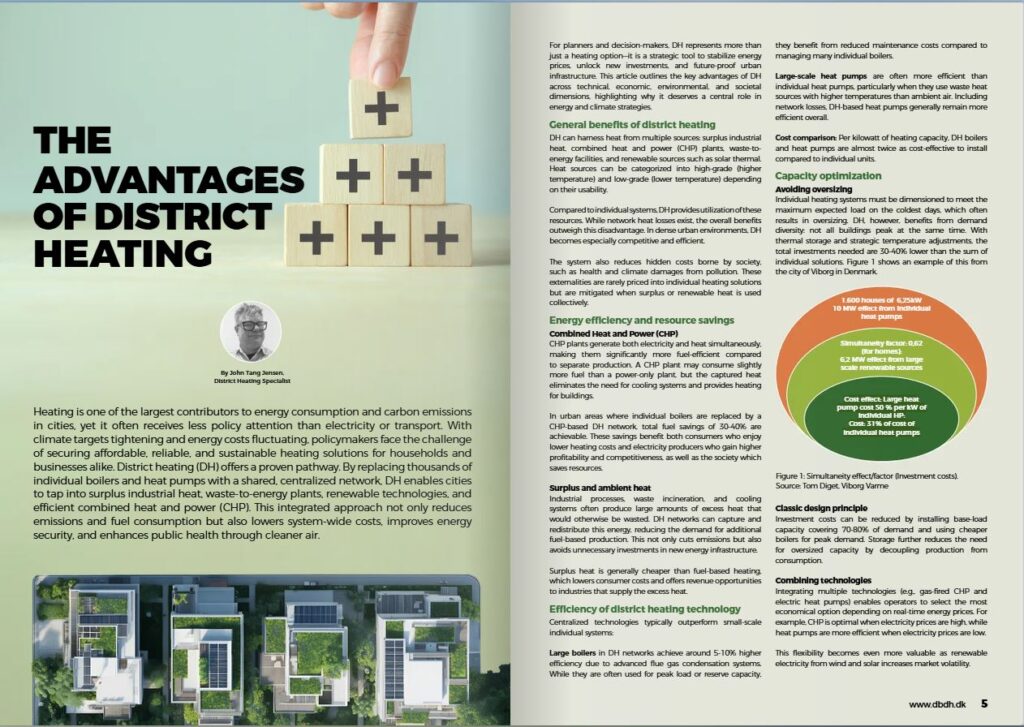Heating is one of the largest contributors to energy consumption and carbon emissions in cities, yet it often receives less policy attention than electricity or transport. With climate targets tightening and energy costs fluctuating, policymakers face the challenge of securing affordable, reliable, and sustainable heating solutions for households and businesses alike. District heating (DH) offers a proven pathway. By replacing thousands of individual boilers and heat pumps with a shared, centralized network, DH enables cities to tap into surplus industrial heat, waste-to-energy plants, renewable technologies, and efficient combined heat and power (CHP). This integrated approach not only reduces emissions and fuel consumption but also lowers system-wide costs, improves energy security, and enhances public health through cleaner air.
By John Tang Jensen, District Heating Specialist
Published in Hot Cool, edition no. 7/2025 | ISSN 0904 9681 |
For planners and decision-makers, DH represents more than just a heating option—it is a strategic tool to stabilize energy prices, unlock new investments, and future-proof urban infrastructure. This article outlines the key advantages of DH across technical, economic, environmental, and societal dimensions, highlighting why it deserves a central role in energy and climate strategies.
General benefits of district heating
DH can harness heat from multiple sources: surplus industrial heat, combined heat and power (CHP) plants, waste-to-energy facilities, and renewable sources such as solar thermal. Heat sources can be categorized into high-grade (higher temperature) and low-grade (lower temperature) depending on their usability.
Compared to individual systems, DH provides utilization of these resources. While network heat losses exist, the overall benefits outweigh this disadvantage. In dense urban environments, DH becomes especially competitive and efficient.
The system also reduces hidden costs borne by society, such as health and climate damages from pollution. These externalities are rarely priced into individual heating solutions but are mitigated when surplus or renewable heat is used collectively.
Energy efficiency and resource savings
Combined Heat and Power (CHP)
CHP plants generate both electricity and heat simultaneously, making them significantly more fuel-efficient compared to separate production. A CHP plant may consume slightly more fuel than a power-only plant, but the captured heat eliminates the need for cooling systems and provides heating for buildings.
In urban areas where individual boilers are replaced by a CHP-based DH network, total fuel savings of 30–40% are achievable. These savings benefit both consumers who enjoy lower heating costs and electricity producers who gain higher profitability and competitiveness, as well as society, which saves resources.
Surplus and ambient heat
Industrial processes, waste incineration, and cooling systems often produce large amounts of excess heat that would otherwise be wasted. DH networks can capture and redistribute this energy, reducing the demand for additional fuel-based production. This not only cuts emissions but also avoids unnecessary investments in new energy infrastructure.
Surplus heat is generally cheaper than fuel-based heating, which lowers consumer costs and offers revenue opportunities to industries that supply the excess heat.
Efficiency of district heating technology
Centralized technologies typically outperform small-scale individual systems:
Large boilers in DH networks achieve around 5-10% higher efficiency due to advanced flue gas condensation systems. While they are often used for peak load or reserve capacity, they benefit from reduced maintenance costs compared to managing many individual boilers.
Large-scale heat pumps are often more efficient than individual heat pumps, particularly when they use waste heat sources with higher temperatures than ambient air. Including network losses, DH-based heat pumps generally remain more efficient overall.
Cost comparison: Per kilowatt of heating capacity, DH boilers and heat pumps are almost twice as cost-effective to install compared to individual units.
Capacity optimization
Avoiding oversizing
Individual heating systems must be dimensioned to meet the maximum expected load on the coldest days, which often results in oversizing. DH, however, benefits from demand diversity: not all buildings peak at the same time. With thermal storage and strategic temperature adjustments, the total investments needed are 30–40% lower than the sum of individual solutions. Figure 1 shows an example of this from the city of Viborg in Denmark.

Figure 1: Simultaneity effect/factor (Investment costs). Source: Tom Diget, Viborg Varme
Classic design principle
Investment costs can be reduced by installing base-load capacity covering 70-80% of demand and using cheaper boilers for peak demand. Storage further reduces the need for oversized capacity by decoupling production from consumption.
Combining technologies
Integrating multiple technologies (e.g., gas-fired CHP and electric heat pumps) enables operators to select the most economical option depending on real-time energy prices. For example, CHP is optimal when electricity prices are high, while heat pumps are more efficient when electricity prices are low.
This flexibility becomes even more valuable as renewable electricity from wind and solar increases market volatility.
Interaction with the electricity system
DH is not only a heating solution but also a crucial tool for balancing electricity markets.
Avoiding curtailment of renewables
When wind or solar generation exceeds demand or export capacity, renewable power may need to be curtailed. DH systems with electric boilers or large heat pumps can absorb this surplus electricity by converting it into heat, which can be stored or used immediately. This avoids wasting renewable energy and provides additional system value.
Grid investment savings
Transitioning from gas boilers to individual electric heat pumps significantly increases electricity grid demand, requiring costly upgrades. DH systems mitigate this by using high-voltage heat pumps (10–60 kV) that are more efficient and cheaper to connect than thousands of low-voltage (0.4 kV) individual units.
Furthermore, DH plants can provide demand-side flexibility by ramping electricity consumption up or down depending on grid needs, supported by integrated heat storage. This reduces the need for costly high-voltage lines and interconnectors.
Operation and maintenance costs
The total Operation and maintenance costs over the lifetime of the system for DH systems are 6–10 times lower than for individual solutions, which further increases their competitiveness.
Economic advantages
Cost reductions for consumers and producers
DH enables heat and electricity producers to share fuel cost savings, resulting in lower energy prices for end-users. When CHP plants set the electricity price, consumers benefit from reduced marginal electricity costs.
Investment savings
By capturing surplus heat, reducing capacity demand, and optimizing production, DH systems save significant investments in fuel-based plants, renewable electricity capacity, and infrastructure.
Participation in electricity markets
DH operators can participate in balancing markets, deliver capacity reserves, and frequency response services. When equipped with both electricity-consuming and producing technologies, along with storage, they can profit from multiple revenue streams while supporting grid stability.
Societal and environmental benefits
Lower emissions: By replacing fossil-fuel boilers and maximizing surplus heat, DH reduces CO₂ and pollutant emissions, improving air quality and public health.
Lower external costs: Although externalities like climate damage and healthcare costs are often not priced into fossil fuels, DH helps avoid them, representing significant indirect savings for society.
Industrial competitiveness: By stabilizing electricity and heat prices, DH strengthens industrial competitiveness, supporting jobs and economic growth.
Integration of future technologies: High-temperature heat pumps, hydrogen plants, carbon capture, and bioenergy facilities can all integrate with DH, making energy systems more flexible and future-proof.
Financial and practical considerations
DH companies usually secure better financing conditions than individual households, leading to lower interest rates and improved affordability.
Moreover, converting a building to renewable individual heating often requires costly retrofits (additional radiators, floor heating, ventilation systems) due to lower system temperatures. In contrast, DH can deliver water at 60 °C, avoiding such expenses and making the transition more practical for existing buildings.
Conclusion
DH is far more than just an alternative to individual heating – it is a cornerstone of efficient, integrated, and sustainable energy systems. By combining multiple heat sources, optimizing capacity, balancing electricity markets, and reducing environmental impacts, DH delivers value to consumers, producers, and society.
Its advantages can be summarized as follows:
- Energy efficiency: CHP, surplus heat, and large-scale heat pumps reduce fuel use and emissions.
- Cost-effectiveness: Lower installation, O&M, and investment costs compared to individual systems, including networks.
- Grid integration: Balances fluctuating renewable electricity systems, avoids curtailment, and saves grid investments.
- Environmental and societal benefits: Cleaner air, reduced climate costs, and improved competitiveness.
- Financial practicality: Easier financing, lower interest rates, and less need for building retrofits.
For policymakers and planners, recognizing and utilizing the full potential of DH makes it possible to achieve overall lower energy prices for consumers and improve industrial competitiveness.
For further information, please contact: John Tang, jhntj@ens.dk
“The Advantages of District Heating” was published in Hot Cool, edition no. 7/2025. You can download the article here:
Did you find this article useful?
Subscribe to the HOT|COOL newsletters for free and get insightful articles on a variety of topics delivered to your inbox twice a month!


